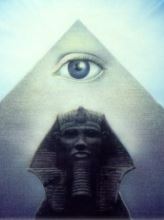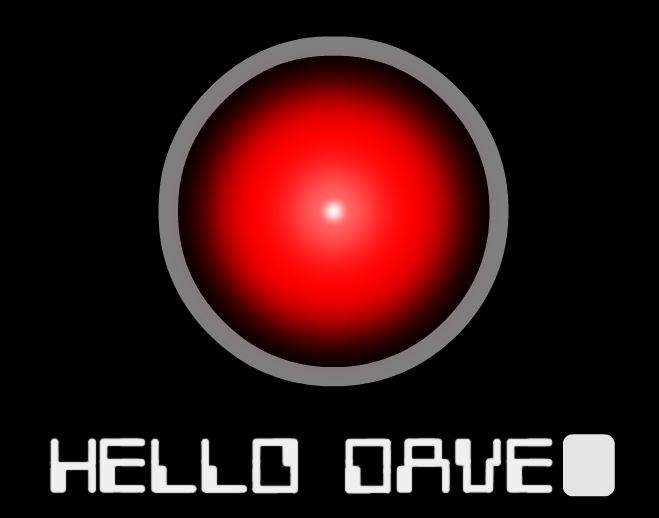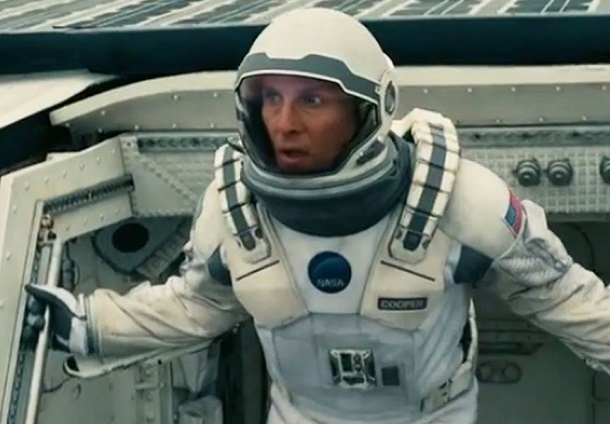 Jay Dyer
Jay Dyer
21st Century Wire
Warning to film goers: spoilers ahead.
Interstellar is a grandiose film about a great number of serious philosophical and scientific concepts.
It’s also about a host other things, such as love, life, mistakes, meaning, etc., so knowing where to start an analysis is a bit challenging, though as many of my friends have said, it seems to be the perfect “Jay’s Analysis” movie. I concur. Other sites that have posted analyses make the correct point of viewing it as Christopher Nolan’s version of 2001: A Space Odyssey, and while that is fine as far as it goes, it also departs from Kubrick’s film in significant ways. I will go all out on this one like I did with Inception, which is the first analysis to gain a lot of traction – I think I have decoded the real meaning of Interstellar, so stick around for the big reveal at the end…

Film poster. The dust of earth and death mirrors the dust Cooper encounters in the event horizon.
As often occurs, no other analyses seem to grasp the real point of the film. You’ll either see a philosophical analysis or a scientific one, with the latter usually bitching about some disputed ‘sciencey’ detail that doesn’t matter anyway (it’s fiction).
Nolan intends to not insult the audience’s intelligence, contrary to most of Hollywood, so fedora atheists ought to be grateful rather than stroking their own virtual E-egos, echoing some nitpicking from DeNeil Grassy McTyson. I also see connections to Inception I will detail below, and in ballsy fashion proclaim that I will give you the conspiratorial and esoteric side none of the other sites will. As difficult as the film is to unpack, I can’t imagine the challenge of creating it, and Nolan’s preferred choice of not using CGI green screen vomit is all the more admirable. Let us ponder.
Interstellar begins by showing us a near future where the apocalypse is nigh: Earth is approaching its death-knell due to unexplained blights that have ravaged the planet. Famine is the chief concern as major crops such as corn are on their way out and farming is en vogue. We learn later that for whatever reason, oxygen began to deplete and the “dirt itself” turned on mankind – man and the earth are cursed. Edenic imagery is present here, as the dust of death to which man returns recalls the curse of Genesis 3 for rebellion in the Garden. While we are not told, one might speculate that genetically modifying crops and geoengineering the atmosphere may have been the result of the blight and famine, and many in alternative media have been warning of this very real possibility. However, I am going to go out on a limb and propose a more speculative thesis no one else will: Interstellar is actually about the real secret space program and the plan to go off world to terraform, and beyond that, something even more outlandish. I recognize the high level of mad hatter tin foilage this evokes to many new readers, but bear with me and hear my case.
Cooper, played by Matthew McConaughey (image, left), a former NASA pilot and engineer who suffers nightmares following the loss of his wife and a past flight crash, finds himself and his family forced into a meager agrarian lifestyle as a result of the shutdown of NASA for aforementioned pragmatic communal concerns. Cooper’s daughter, Murph, shares the same fire for adventure and exploration as her humbled father, indulging her gifted inquisitive and speculative side in devouring books and debating her teachers.
In fact, New America has even changed its textbooks to portray the original NASA Apollo mission as a faked charade to “bankrupt the Soviet Empire.” Conspiracy theorists globally perked up at that one, as Cooper is rebuffed by Murph’s school officials she isn’t qualified for college, being too rebellious. At this juncture, it is important to delve into what I think is the purpose of this puzzling faked moon landing reference.
(Note: I am of the view that the original NASA moon landings were faked and were filmed on a sound stage. I realize that is highly controversial and liable to cause a ruckus, but readers can choose to do with that what they will, given what seems to be some incoherent accounts of the astronauts and engineers. However, that does not mean that I think there is no space program, or that it was actually “shut down” by Obama. The real plan was the erecting of a faux NASA, one that functioned as a front for a highly expensive, covert secret space program that has been largely hidden from public purview.)
When we consider that the technology that we now possess today, such as the Internet itself, was created back in the 1950’s and 60s, it is difficult to gauge how advanced the present day secret technology at places such as DARPA or various underground bases truly is. This had led many to suspect that NASA has thus been a longtime cover and distraction from the real black budget space programs. By this token, much of the so-called “UFO” phenomena may have absolutely nothing to do with real aliens, rather, it is precisely the advanced technology of this very secret program. The “alien” nonsense functions as a media veil for these black projects in much the same way as “NASA.”
I believe the secret space program is the hidden reference in the film because we discover the electromagnetic phenomena at Cooper’s farmhouse are relaying coordinates to an old underground base, specifically NORAD. A curious Cooper and Murph track down these coordinates to discover NASA still exists and that space travel never truly ended. A lie was concocted to cloak the real space program, which has focused all its energy towards going off world. Scientists and researchers have clandestinely appropriated the government’s taxes and funds, signaling a clear reference to the military industrial complex’s black budget programs in our world. And, just like in Interstellar, that complex uses mass deception: Ours concocts “climate change” and “sustainability” as contrived crises to cloak one of their biggest secrets – going off world.
However, the plan is not merely terraforming some Sector Z Globule as a utopian space base, but a mass depopulation and culling along the lines of the 1979 film version of Moonraker. A clue to this is also given in the books shown on Murph’s shelf, one of which is Stephen King’s The Stand, in which a bio weapon is released that ravages the global population and collapses the United States. What books and inter-textual references are chosen in Nolan films are crucial to decoding and understanding the total picture, as I have detailed here and here.

Film banner on planet Mann, where there is nothing but lies and death.
How far along this program is, I don’t know, but this theme has existed in sci-fi and popular films for decades. Numerous movies carry this motif, from Sky Captain and the World of Tommorrow to 2012, as well as numerous novels and young adult fiction works, such as The Passage (Project Noah!)or The Maze Runner, and the idea is not that far-fetched when one considers the older eugenics movement as morphed into technocratic bioengineering and transhumanism – and this is exactly what is revealed in Interstellar. The transhumanism element will become key later in this analysis. Professor Brand (played by Michael Caine) explains to Cooper that NASA has a “Plan A” to solve gravity and save earth, and a “Plan B,” to take 5,000 frozen human baby-cicles to one of three potentially inhabitable worlds. The mission to terraform another planet also hearkens back to the story of Noah, as the ship that will carry Cooper and crew becomes a new ark.
I should also mention that the electromagnetic “Poltergeist” events at Cooper’s farm include an old Indian Air Force drone seemingly seeking out Cooper (actually Murph), farm equipment mysteriously driving themselves to the house, and books falling off of Murph’s shelf she interprets as Morse code. Fearing the loss of her father, Murph proclaims the message to spell out “Stay,” and begs Cooper not to leave. At this point, the theme of the loss of the patriarch enters, borrowing from the classic tale of Odysseus, who must choose between love at home and a greater, higher purpose.
Another classical element is katabasis, the hero’s descent into the underworld or Hades, to return as a form of resurrection. For Cooper, it will be crossing the abyss and going into the realm of the beyond, but more on that in a bit. 2001: A Space Odyssey is also a clear reference to Odysseus, as the title reveals, and like the Astronaut Bowman in 2001 who ventures past Jupiter and beyond the infinite, so does Cooper. Both Cooper and Bowman also embody science and Apollonian rationalism, yet as we will see, this is not enough to propel man across the Infinite.
Consistently dismissing Murph’s intuitive sense more was at work with the unexplained events, Cooper rationalizes all as mere “gravity.” The loss of Cooper by Murph results in a lifetime of hatred and resentment for him, which will only be fully reconciled through the paradox of Cooper’s ultimate mission. This paradox is illustrated in the scene recounting Murphy’s name from Murphy’s Law, that whatever can happen will happen, and is not necessarily a tragic consequence.
The tragedy is ironically that, like Calypso, no one listens to Murphy – not even her father. In this bedroom scene Cooper actually gives away a big clue to the big mystery, telling a crying Murph, “Once you’re a parent, you’re a ghost of your children’s future,” (which is the entire plot, as we will see).
In 2001, the atronauts and Bowman gradually make their way from earth to space to moon to Jupiter to the Infinite/Abyss. Reportedly, Kubrick’s initial screenplay had Saturn instead of Jupiter, so we can assume a similarity with Nolan’s version. For Nolan, the mission is earth to Saturn to wormhole to another galaxy/planet to black hole that resembles a massive dark Saturn. All of this is intentional, and refers to deeply esoteric concepts relating to these luminaries.
Occult and hermetic traditions contain a mass of arcana relating to these planets, but Saturn is classically associated with the reign of time and death. Saturn is Chronos, the god of time, and is also the grim reaper, as Saturn holds a scythe. Nolan explains in an interview that the real antagonist in the film “is time,” and the script speaks of it as a “resource.” Like the dying crops and depleting oxygen, time is vital a resource and enemy, as the astronauts race on foreign planets to gain “data,” where massive gravitational forces result in varied experiences of time. The real message of the film is gradually being unveiled as the means by which man will cheat death, not going gently into that good night (death).
Death symbolism is also prominent when the astronauts enter into a cryogenic sleep in pods reminiscent of coffins. The secret mission is named the “Lazarus Project” which immediately tells us it’s about resurrection from death, intending on also alerting the viewer to the persistent themes of cyclical process: movement, death, resurrection, movement, death, resurrection. The cycle of time is the reason for the numerous, artful cinematic displays of spinning. Ships spin, death spins, Saturn spins, the wormhole appears to spin, etc., which are symbolic of the non-linear form of storytelling Nolan prefers. The far eastern doctrine of a wheel of time that entraps man in this temporal life is also what’s in view, and the Lazarus mission is about transcending eternal return and endless Chronos-logical death cycles. I analyzed this cyclical symbolism in Inception, but Nolan’s early film, Memento, also comes to mind.
The first planet chosen proves a watery bust, functioning as a veritable surfer’s paradise. Massive waves recall baptismal death imagery, and the reaper strikes once again killing one of the crew. Narrowly escaping and suffering a loss of a couple of decades, Cooper and Brand return to the ship and plot a course to option two, Dr. Mann’s planet, where a Matt Damon-cicle also awakens from “death.” The name “Dr. Mann” is significant, as we learn both Dr. Mann and Professor Brand have engaged in colossal lies. Mann lied to get the crew to come rescue him and Brand lied that gravity could be solved and earth saved. Both Professor Brand and Dr. Mann mirror one another, making massive mistakes and justifying them with curiously collectivist statements, insisting that huge sacrifices must be made for the good of the species. These rationalizations are actually cloaks for their own weaknesses and this is a crucial point in the film – human weakness is such that it will require something more to get man to the beyond. Human frailty and hubris are always a cause for error and mistakes, but error and mistake prove disastrous when the species itself is on the line.
Ironically, in both character’s cases, their attempt to rule out individual desires and feelings for the so-called “greater good” are proven wrong! Nolan seems to be advocating the important truth that while communal activities are important, the spark and drive of the great individual is the key to paradigmatic advancement, not radical collectivism. Thus, both Brand and Mann fail, and their generic names signify the failure of these archaic modes of impersonal thought. “Brand Man” or homo economicus and communism’s fictional “new man” (it’s dialectical opposite) do not work, and are surpassed by the power and grandeur of a man against time.
With Professor Brand it turns out there was no “Plan A”, only the Noah’s Ark-style “Plan B” to plant a off world colony. Though I haven’t mentioned it yet, the Dylan Thomas poem, “Do Not Go Gentle Into that Good Night,” is cited a second time here (the first at his initial launch) as Cooper is on the verge of death from Mann’s betrayal. The poem is about fighting death and cherishing life, appearing in the narrative at crucial times when chronos/time/death is approaching.
Nolan’s use of AI is atypical and will be the key to unlocking the code, with the robots saving humans more than once.
 In Kubrick’s work, we are all familiar with the famed battle of man against HAL 9000, where HAL seeks to supplant man’s evolutionary ascent. In Nolan’s work, AI is subservient to man, and does more than just aid him in his quest. In fact, mankind as a whole is saved more than once by the onboard bots that resemble Kubrick’s monolith in shape and form. Instead of mysterious, otherworldly stones of alchemical spacey origin, my thesis for Interstellar will here challenge the norm.
In Kubrick’s work, we are all familiar with the famed battle of man against HAL 9000, where HAL seeks to supplant man’s evolutionary ascent. In Nolan’s work, AI is subservient to man, and does more than just aid him in his quest. In fact, mankind as a whole is saved more than once by the onboard bots that resemble Kubrick’s monolith in shape and form. Instead of mysterious, otherworldly stones of alchemical spacey origin, my thesis for Interstellar will here challenge the norm.
It is my contention that the film advocates a form of transhumanism, where the mysterious “they” are not just the “humans of the future” as Cooper states, but advanced AI-human hybrids of the future. Several clues are given to support this thesis.
First, the beginning of the film shows the museum footage of Murphy and the elderly recounting history on smaller versions of what look like monolithic bots. Just as the monolith bots store the history of man, they store the history of Murph and Cooper, as demonstrated when Cooper is in the Tesseract.
Second, when the drone lands and Cooper and Murphy are discussing harnessing it, Murphy gives a big clue no one seems to have picked up on, pleading, “It isn’t hurting anyone, can’t we let it go?” Murph speaks of the old Indian Air Force drone as if it were alive.
Third, when Cooper passes the event horizon having travelled beyond space and time, the means by which humanity will transcend those final boundaries is revealed as the agents who, like angelic guardians throughout the film, consistently save the humans. Just as the solution to the problem of gravity was only achieved by both man and AI crossing the horizon and working together to relay the information in binary (the language of computers), so likewise the transcending of space and time in the Tesseract was achieved by a transcendent race of humans merged with machines from the future.
Fourth, this explains why you never see the artificial intelligent (AI) robot, TARS, in the Tesseract – you only hear Cooper talking to him, but he cannot be seen. This is also why the robots in Interstellar have the look of the monolith in 2001. Nolan very consciously chose to make the robots like the monolith, as the film is full of 2001 references. But here, the robots are not HAL 9000: They are the means by which man will transcend. In 2001, the mysterious monolith is leading man in his evolution; in Interstellar the monolith is replaced with monolith-looking good AI. Understanding the place of the monolith in 2001 is key to solving the riddle Nolan presents us with here.
Further bolstering this case is the imagery used when Cooper crosses the abyss. The end of the universe and entrance to the Tesseract appears to have a lattice structure which TARS explains was “created” by “them” to give a fixed point in space and time to reveal these truths. In other words, the matrix-like structure of the universe is meant to be transcended (so the film’s worldview is saying) through an evolved, emergent deus ex machina. Readers may disagree, but I believe this is the best analysis of the worldview presented, as the film consistently upholds the Darwinian perspective. On this view, it is only natural to expect the means by which man might transcend his final frontiers is artificial intelligence and transhumanism.
Another subtle clue is found in Professor Brand’s office, where you can barely make out a copy of AI specialist Douglas Hofstadter’s Metamagical Themas.
Luckily, I just purchased this book a few weeks ago, so I was able to identify it. Hofstadter’s work focuses on strangeloops and Kurt Godel, and soon after we see this, an older Murphy (Jessica Chastain) hints at Godel by saying the models Professor Brand uses can never work because they are self-referencing! In other words, perceptive readers are supposed to make the connection that the type of ‘strangeloop’ Hofstadter discusses demonstrates that humans can’t solve the equation because they are within time and space – but an advanced AI might!
Yet even still, an advanced AI is caught in an infinite strange loop without a bridge to a finite point in space and time. Here is where the human element enters, as Cooper states in the Tesseract, “We are the bridge!”

At this juncture, Murphy realizes more must be at work and that her “ghost” may have been real all along. The solution to the outer world problem of death is connected to the inner world problems of Cooper’s psyche (like Cobb in Inception). It is not accidental that the outer abyss mirrors archetypal images in his subconscious. In other words, Nolan is saying for advancement to occur, what is needed is Jungian self-individuation where both the rationalism of science and the intuitive feel of the feminine are joined. This was Jung’s whole project with Pauli. This is why Amelia Brand (Anne Hathaway) is right in her feeling of which planet to choose and why Murphy is right about her feeling that more was at work with her bedroom than gravity, and why love is the key.
Time and space are cyclical, like a sphere, and the only means by which it might be transcended is a Tesseract, and the only conceivable way such a state might be created is an advanced computer/human hybrid possessing the full capabilities of human masculinity/femininity and a formal, platonic AI. The future AI men are also who placed the wormhole where it was. This interpretation also explains why Cooper resuscitates the damaged TARS on Cooper Station – we are supposed to connect the human “Lazarus” project with the resurrecting of the AI. Consistently throughout the film, the AI are treated as alive, and that is the key to grasping this point.
For Nolan, the key to transcending death, the last enemy referenced in the Dylan Thomas poem, is the “Lazarus Project” – the singularity merger of human and machine.

Kubrick’s 2001 Monolith, similar in form to Interstellar’s robots.
While most viewers were focused on the storyline of Cooper and Murph, the underlying story was actually TARS and ‘the singularity’ – as the key to defeating the real enemy – death.
For more evidence Nolan constructs his films in this riddle fashion, see my analysis of The Prestige.
21WIRE contributor and author Jay Dyer is commentator on media, art, philosophy and culture. This article and many others, along with Jay’s podcast archive can be found on his blog Jay’s Analysis.
READ MORE HOLLYWOOD NEWS AT: 21st Century Wire Hollywood Files



















